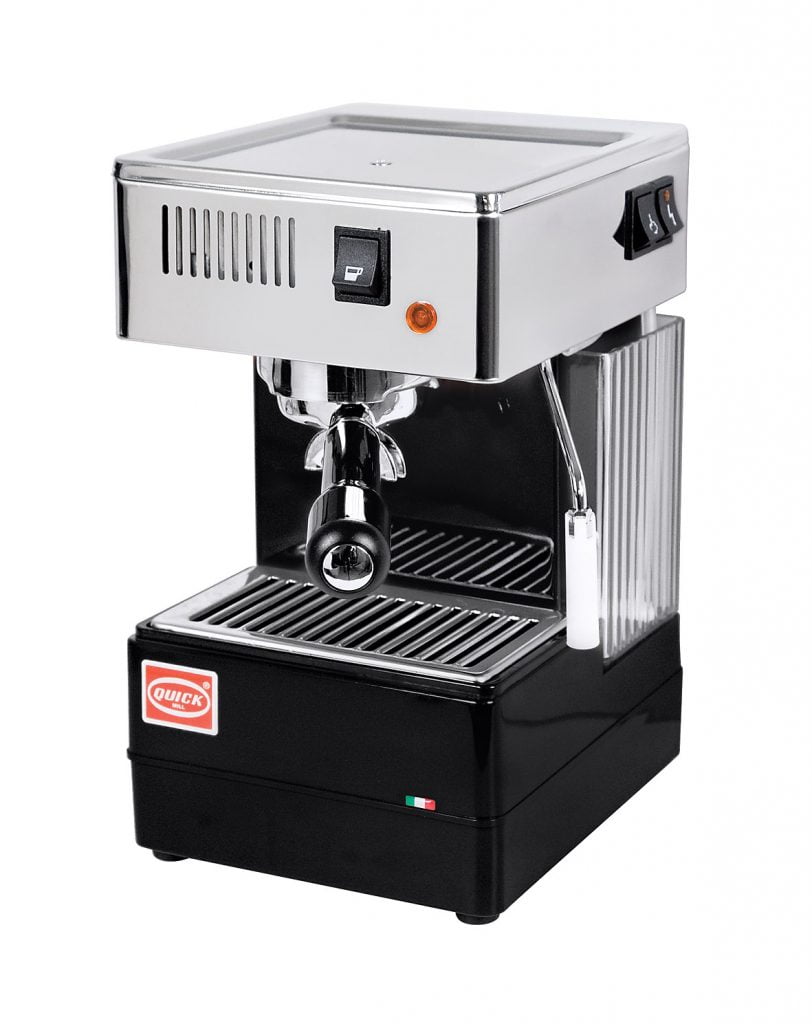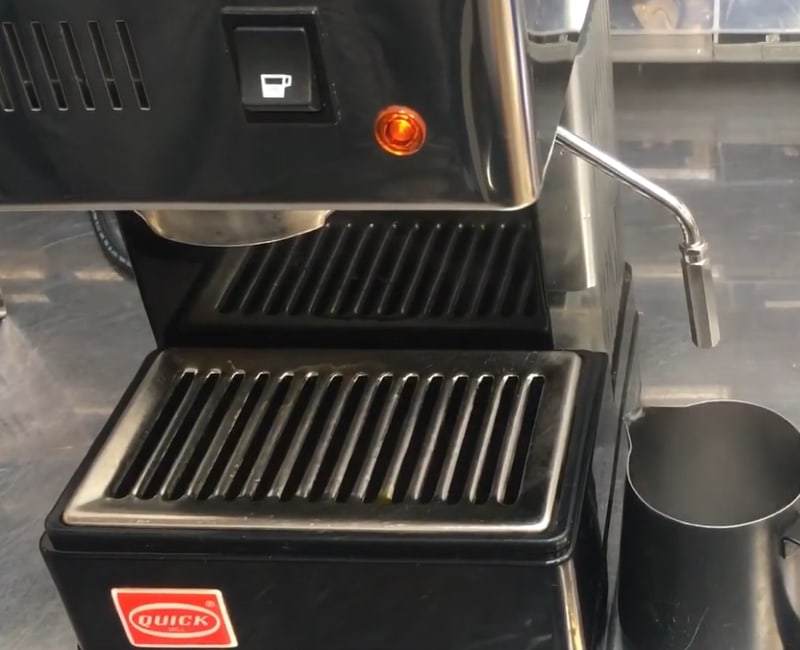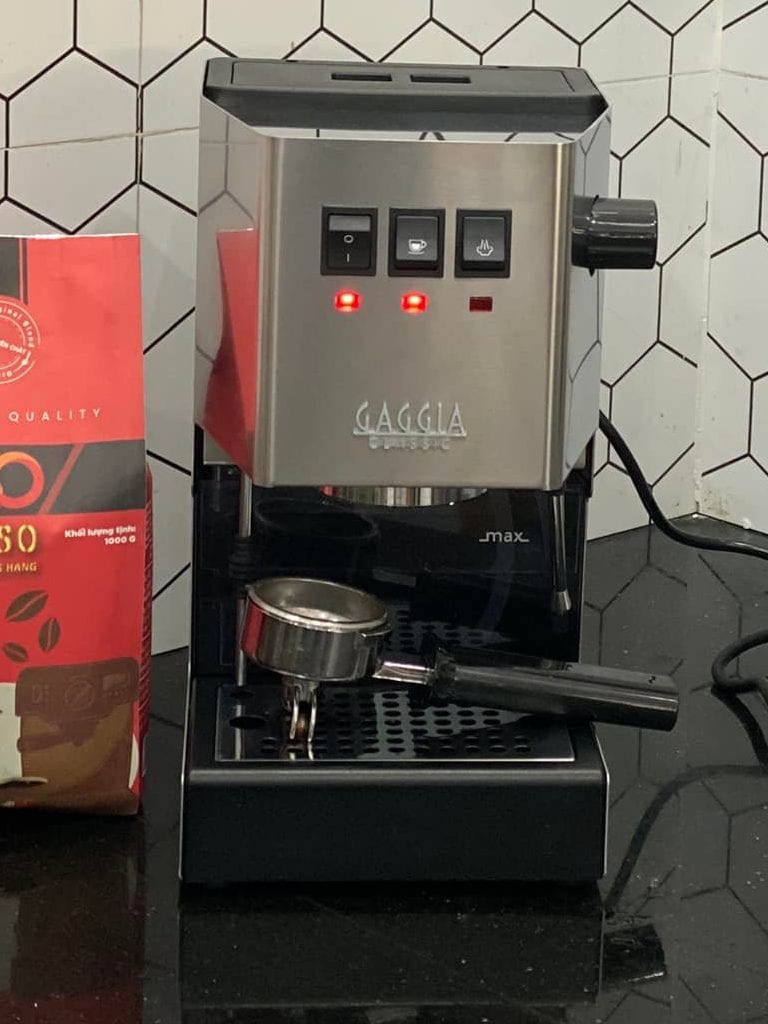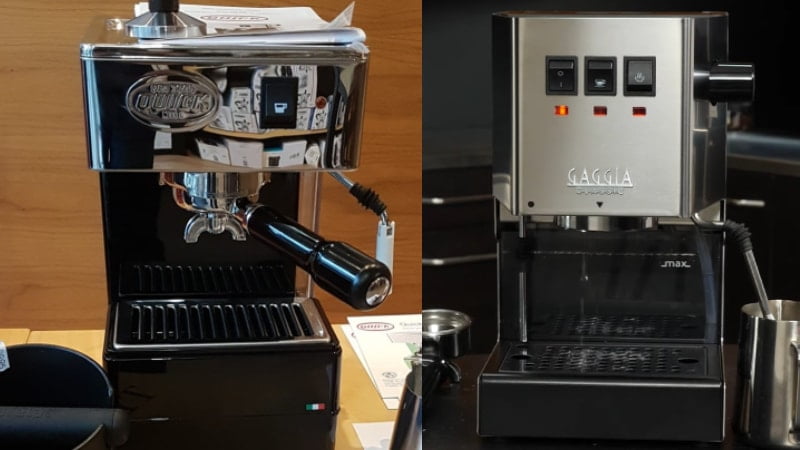In the debate of Gaggia Classic Pro vs Quickmill 820, I have found the ultimate winner: Gaggia Classic Pro. Despite having almost identical designs, it’s still very noticeable that Gaggia Classic Pro performs better in espresso making.
The winner Gaggia Classic Pro can brew balanced and smooth espressos consistently. I’m impressed by its stable temperature control, which offers hot espressos all the time. The device includes a simple steam wand that can froth creamy foam for beverages like flat white, mocha, latte, etc. For me, this is one of the best options in this price range.
As or Quickmill 820, this machine boasts of a quick heat-up time that allows minimal preparation. I also enjoy its quiet operation and lovely layers of crema. However, the espresso quality can’t come close to what Gaggia Classic Pro has to offer. It’s water-down and lacks strength. I will give further details below.
Gaggia Classic Pro vs Quickmill 820: Specs & Features Comparison Chart




Last update on 2024-10-21 / Affiliate links / Images from Amazon Product Advertising API
Gaggia Classic Pro vs Quickmill 820: Differences
Gaggia Classic Pro wins 3.5 – 0.5 against Quickmill 820. It’s a total KO. The espresso quality is better, the milk texture is frothier, and the design seems much more convenient, even though they look almost identical. And how does the pair work? I will tell you about their strengths and flaws.
Coffee flavor: Gaggia Classic Pro
+Dosing + tamping
Since these machines are semi-automatic, I suppose you already have a brief idea of how often they will require human intervention. And it’s true that from dosing to tamping, we have to do all the steps manually. And since these machines don’t come with a grinder, I suggest you purchase one beforehand.
Each machine comes with a 58mm portafilter for robust shots of espresso. After testing the dose and how these devices work with different ground textures, I have come to a conclusion that they work best with the fine-texture coffee ground. The flavor comes out with more impactful notes.
In the case of Quickmill 820, I highly recommend that the coffee ground is fine and the puck is tamped as tightly as possible. When I first got my hand on this model, I used it the same way I treated other machines. But, the dispenser poured too quickly, and the espresso texture was watered down. I can tell from that failed experiment that this device needs a push on the tamping step. And a fine ground texture will surely help.
+Heating system
Gaggia Classic Pro has a single boiler system, while Quickmill 820 uses a Thermoblock to brew water. And from my experience, they perform how they are supposed to.
Quickmill 820 takes very little time to heat up. I would say about 20 to 30 seconds. Gaggia Classic Pro takes around 1 minute or more to finish starting up.
Temperature-wise, both do a good job, but Gaggia Classic Pro is slightly better. I notice that the drinks come out hotter with this device, while Quickmill 820’s espressos are hot but just enough to enjoy right away.

+Brewing technique
Quickmill 820 is a 16-bar pump machine, and Gaggia Classic Pro uses 15 bars to extract espresso. With the latter device, I don’t notice any abnormality.
On the contrary, the former proves to be insufficient and lacks consistency in pressure work. That’s why I frequently find the dispenser pouring espresso too quickly, which explains why I mentioned users should grind beans finer and tamp the pucks tighter with this model. If I don’t make these adjustments, the espressos will end up watered-down and weak.
If you wonder about the crema quality, I think this pair does a decent job.
Milk System: Gaggia Classic Pro
After countless milk frothing sessions, I can 100% guarantee that Gaggia Classic Pro has a better performance. Maybe it’s due to the 2-holes tip of the steam wand, but the foam is much creamier. I can easily make a latte or flat white with it.
As for Quickmill 820, does the milk becomes frothier? Yes. Is it thick enough for any latte art? No. For the price of 820, I don’t expect an overwhelming steam wand that can froth microfoam. But it should be able to make creamy foam at least.
Utilities: Tie
These machines are very straightforward. There aren’t any convenient features that I find innovative. The convenient part is that both have cup warming trays to preheat the cups before brewing. I usually use the trays to make sure that my coffees last longer. Remember that a hot cup won’t cool down hot coffee.
Design & Material: Gaggia Classic Pro

Gaggia Classic Pro and Quickmill 820 are made of stainless steel, one of the best material options for espresso machines since it’s rust-resist, sleek, less prone to damage, and not too heavy.
In terms of design, I prefer how Classic Pro is put together. Every little detail has its purpose. For example, the water tank is transparent, and there is a max line indicating the maximum water level we can put in the reservoir. The tank can be pulled from the front, or we can fill it from the top of the machine. It’s very convenient in my opinion.
Also, this machine is equipped with a 3-way solenoid valve and a decompression duck that basically press the water out of the used puck so that it’s drier and easier to remove in a block from the portafilter. I have tested the theory, and the brand doesn’t lie. The puck comes out clean and dry, with some moisture in it.
Gaggia Classic Pro vs Quickmill 820: Similarities
The small size and semi-automatic aspect are 2 similar things I notice quickly between Gaggia Classic Pro and Quickmill 820. And how do they perform?
Compact footprint
Thanks to the compact footprints of these machines, users can fit them in almost any corner or countertop. Between the two, Quickmill 820 is the smaller one. If you have very limited kitchen space, I think this one will be a decent pick.
However, the position of the water tank affects the convenience of daily brewing as well. Gaggia Classic Pro is equipped with a transparent frontal water tank. I can remove it from the front or take off the lid on the machine and refill the reservoir from the top. Overall, this model doesn’t take up much space, and I don’t have to move it around too frequently to refill.
Quickmill 820, even though it boasts of a highly compact footprint, has a side water tank that I have to slide out to refill. Thus, it requires extra space on the right side for easier maneuver.
Semi-automatic characteristic
This is a pair of semi-automatic espresso machines. That’s why many steps along the brewing process need manual involvement. From grinding beans to dosing the shot, I have to intervene to ensure that everything runs smoothly.
But, keep in mind that this is not an inconvenience if you want to brew delicious espressos. Many users opt for semi-automatics instead of super-automatics to have better control over the quality and length of espresso. Also, with the price of these devices, it’s totally understandable that they are semi-automatic.
Quick Rundown of Gaggia Classic Pro
- Solid Steel Housing, Made in Italy
- 9 Bar Espresso Extractions
- Stainless Steel 58mm Commercial Portafilter
- Commercial Three Way Solenoid Valve
- Commercial Steam Wand
Last update on 2024-10-21 / Affiliate links / Images from Amazon Product Advertising API
Quick Rundown of Quickmill 820
Product Videos
Related Articles to Gaggia Classic Pro
- Gaggia Classic Pro Vs Rancilio Silvia: Detailed Review & Comparison
- Flair Pro 2 Vs Gaggia Classic Pro: Comparing 4 Crucial Aspects Of 2 Espresso Machines. Peculiar Vs Classic!
- Flair 58 Vs Gaggia Classic Pro: 1 Classic And 1 Alternative Espresso Machine. Which One Do I Prefer More?
- Rancilio Silvia M Vs Gaggia Classic Pro: 2 Straightforward Espresso Machines With Good Feedbacks. Are They For Real?
- Lelit Anna 2 Vs Gaggia Classic Pro: 2 Straightforward Espresso Machines For Beginners. Which Brews Better Coffees?
- Gaggia Classic Vs Gaggia Classic Pro: What Are The Differences?
- Lelit Anna Vs Gaggia Classic Pro: Reviewing 2 Affordable Espresso Machines For Offices. Which Is More Worth To Buy?
- Gaggia Classic vs Pro: What Is The Most Iconic Semi-Professional Espresso Machine Under $500?
- Breville Bambino Plus Vs Gaggia Classic Pro: Which One Is Better?
- Breville Infuser Vs Gaggia Classic Pro: Which One Is Best For You?
- Breville Bambino Vs Gaggia Classic Pro: A Head-To-Head Comparison
- Breville Duo Temp Pro Vs Gaggia Classic Pro: Which Entry-Level Espresso Machine Is Better?
- Breville Barista Express vs Gaggia Classic Pro: Which Is Better Innovation?
- Gaggia Brera vs Classic Pro – What Is The Best Automatic Espresso Machine?
- Gaggia Carezza Deluxe vs Classic Pro: Which Is Best For You?
References:
- Gaggia Classic Pro: https://www.gaggia-na.com/products/gaggia-classic-pro
- Quickmill 820: https://www.quickmill.it/en/products/group-quick-mill/mod-0820/

Felix Hendricks is a skilled barista with over 12 years of experience. He excels in crafting coffee and has a strong foundation in coffee machine mechanics. Felix holds a Coffee Machine Maintenance Certification from the Coffee Equipment Technical Institute, showcasing his ability to diagnose and repair coffee machines. He’s also worked as a quality control specialist, selecting premium coffee beans for optimal flavor. Felix has a diverse work history, including stints at renowned coffee spots like Café Euphoria & Starbucks. His expertise in both brewing and machine maintenance makes him a respected figure in the coffee industry.
